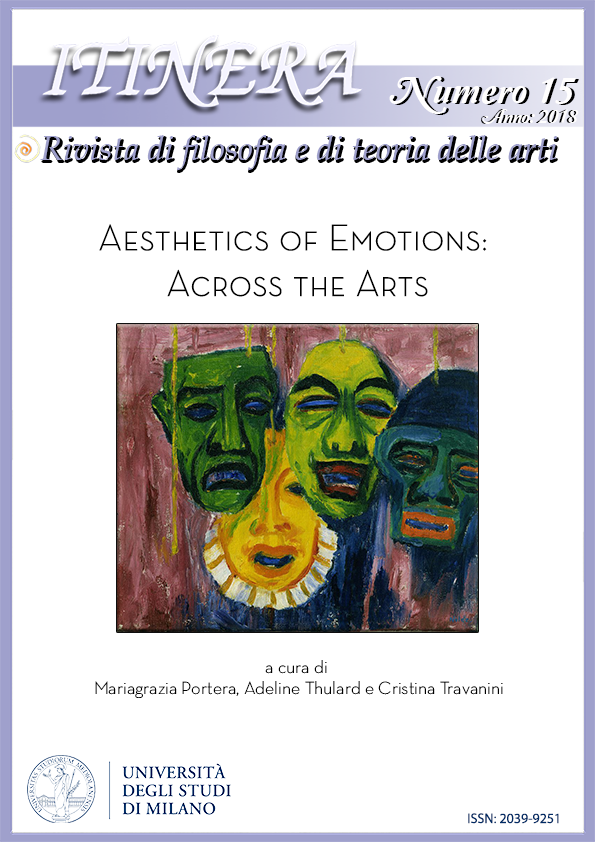Havarie by Philip Scheffner: an Experiment in Erratic Empathy
DOI:
https://doi.org/10.13130/2039-9251/10511Abstract
In recent decades, many studies have been published on the topic of empathy across a range of disciplines. Being empathic is today almost a social duty, amplified by the possibilities enabled by new media in terms of getting directly in contact with stories and experiences of distant people simultaneously. The general trend is arguably that of focusing on the fusional relation between subject and object, without taking into account the distance and conflict implicit in sensing the other. The latest film of the Berliner visual artist Philip Scheffner, Havarie (2016), offers some compelling and fresh cinematic devices to challenge other kinds of empathic relation with the spectator, focusing on an erratic temporality that avoids striking actions and takes position against the idea of one, unique, right image to represent reality.
Riferimenti bibliografici
BARON-COHEN, Simon, Zero Degrees of Empathy. A New Theory of Human Cruelty and Kindness, Penguin, London 2011.
BLOOM, Paul, “Against Empathy”, Boston Review, 39/5, 2014, pp. 14-19.
CHEN, Nancy N., “Speaking Nearby: A Conversation with Trinh T. Minh-Ha”, Visual Anthropology Review, vol. 8, n. 1, Spring 1992, pp. 82-91. Available at the following address: https://docfilmhist.files.wordpress.com/2008/09/chen.pdf.
COPLAN, Amy, GOLDIE, Peter (ed. by), Empathy. Philosophical and Psychological Perspective, Oxford University Press, Oxford 2014.
EHMANN, Antje, GUERRA, Carles (ed. by), Harun Farocki. Another Kind of Empathy, Fundación Antoni Tàpies, Barcelona 2016.
FAROCKI, Harun, “Einfühlung”, in Hebbel am Ufer (ed. by), 100 Jahre Hebbel Theater. Angewandtes Theaterlexikon nach Gustav Freytag, Berlin 2008, pp. 21-22; english translation in, Id. “Empathy”, in Harun Farocki. Another Kind of Empathy, ed. by A. Ehmann, C. Guerra, Fundación Antoni Tàpies, Barcelona 2016, pp. 104-105.
GALLESE, Vittorio, GUERRA, Michele, Lo schermo empatico. Cinema e neuroscienze, Raffaello Cortina, Milano 2015.
MULVAY, Laura, Death 24x a Second. Stillness and the Moving Image, Reaktion Books, London 2006.
RANCIÈRE, Jacques, Le spectateur émancipé, Édition La Fabrique, Paris 2008.
NICASTRO, Clio, “Identità, identificazione e riconoscimento a partire dall’idea di Einfühlung in Harun Farocki”, in L. Farinotti, B. Grespi, F. Villa (ed. by), Harun Farocki. Pensare con gli occhi, Mimesis, Milano 2017.
NICASTRO, Clio, “Storia di un’ordinaria avventura” [online], in Filmidee #17, Lo stato delle cose, published on May 5th maggio 2016. Available at the following address: http://www.filmidee.it/2016/05/havarie-storia-di-unordinaria-avventura/.
NOWAK, Magdalena, “The complicated History of Einfühlung”, Argument, vol. 1, 2/2011, pp. 301-326.
PEDWELL, Carolyn, Affective Relations: The Transnational Politics of Empathy, Plagrave, Basingstoke 2014.
PINOTTI, Andrea, Empatia: storia di un’idea da Platone al post-umano, Laterza, Bari 2011.
SCHEFFNER, Philip, “Statement of the film project Havarie” [online], September 30th 2015. Available at the following address:
http://havarie.pongberlin.de/sites/default/files/downloads/HAVARIE_Press_Kit_en_0.pdf
Dowloads
Pubblicato
Fascicolo
Sezione
Licenza
Gli autori che pubblicano su questa rivista accettano le seguenti condizioni:
1. Gli autori mantengono i diritti sulla loro opera e cedono alla rivista il diritto di prima pubblicazione dell'opera, contemporaneamente licenziata sotto una Licenza Creative Commons - Attribuzione - Condividi allo stesso modo 4.0 internazionale che permette ad altri di condividere l'opera indicando la paternità intellettuale e la prima pubblicazione su questa rivista.
2. Gli autori possono aderire ad altri accordi di licenza non esclusiva per la distribuzione della versione dell'opera pubblicata (es. depositarla in un archivio istituzionale o pubblicarla in una monografia), a patto di indicare che la prima pubblicazione è avvenuta su questa rivista.
3. Gli autori possono diffondere la loro opera online (es. in repository istituzionali o nel loro sito web) prima e durante il processo di submission, poiché può portare a scambi produttivi e aumentare le citazioni dell'opera pubblicata (Vedi The Effect of Open Access).





